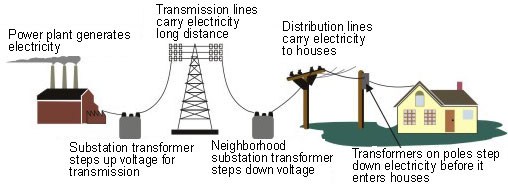
The Grid
The United States power grid, more than 450,000 miles of high-voltage transmission lines, is the backbone of the 21st century. “Smartgrids” and “going off the grid” are common terms, but… What is the grid? Really?
Could you draw it?
Could you find it?
The Components:
- Power Plant, the source of energy generation
- Plant Substation, where voltage is stepped-up for long-distance transmission.
- High Voltage power lines, the infrastructure which conducts electricity over long distances.
- Neighborhood Substation, where voltage is then reduced for neighborhood power lines.
- Distribution lines, the infrastructure that gets power from neighborhood substations to homes
- Transformers, finally, step down electricity before it enters a home.
Here is a more in-depth dive on how the grid works.

The United States “Grid” is actually three grids
- The Western Interconnection (Pacific Ocean to Rocky Mountains)
- The Texas Interconnected System (Most of Texas)
- The Eastern Interconnection (Atlantic Ocean to Rocky Mountains)

What Makes a Grid Smart?

Grids were originally unilateral power delivery networks, unresponsive, and vulnerable to shortages during peak usage. The most glaring inefficiency of the original grid was(is) the way that factories would produce the amount of power needed during peak-usage ALL DAY. This meant that for the majority of any given day, factories produced far more than necessary.
But, as the century-old grids are overhauled with new components, they are becoming “Smart Grids." The American Recovery and Reinvestment Act of 2009 has involved more than 4.5 billion dollars invested in the parts and services to creating a smart grid. Smart Grid installations include many kinds of updated, heavily automated components. These new components are not only smart because of their increased efficiency, they also make power grids more reliable and resilient.
As a result of multilateral power delivery, a network of homes outfitted with photovoltaics can supply the power needed by power plant-dependent homes on the occasion of a factory disruption or shortage, thus preventing the notorious emergency situation of neighborhood brown outs or black outs.
Many utility companies are beginning to recognize the viability of partnering with residential power producers as partners, this way, strengthening their grid and their supply capacity: Supplanting the need of a new power plant.
What does this mean for 2050?
Do these smart grid developments represent the electricity infrastructure of 2050? Or, are there more changes to come? While these improvements are helpful and necessary, what more would you suggest?
Describe your vision to AEM and win.
For more visit energy.gov.
[a]http://worldactivitys.blogspot.com/2011/03/smart-grid-architecture.html








